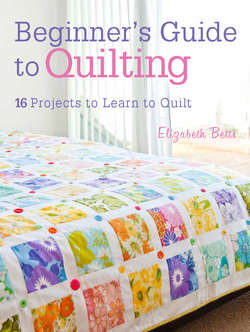Читать книгу Beginner's Guide to Quilting - Elizabeth Betts - Страница 11
На сайте Литреса книга снята с продажи.
ОглавлениеQuilting
Quilting is the process that holds the layers together. It is decorative, adding pattern and texture, but also functional – without quilting, the wadding (batting), which gives the quilt warmth, would ball up within the quilt after a few washes. Wholecloth quilts are made from a single piece of fabric that is quilted, which is a great way of using a favourite piece of fabric without piecing it. Give yourself time to ponder on whether you wish to hand or machine quilt, and what sort of design you wish to use. Look through books and go to quilt shows for ideas on how others have used quilting to enhance their quilts. For inspiration, look at the fabrics used in quilts – fabrics with circles may inspire curved quilting, and geometric shapes might suggest straight line quilting, or you can just quilt an allover pattern.
Whether you hand or machine quilt, always start in the middle and work your way out to the edges. This helps to smooth the layers as you work.
Marking the quilting pattern
You can stitch around the pieces of fabric, using your eye for guidance, but in most instances you will want to mark your quilting lines on the top. You can either mark your quilt up before assembling the layers, which is good as there are no pins to get in the way, or afterwards, which is handy if using a chalk marker as it rubs off easily and may otherwise disappear by the time you start quilting.
There are a wide variety of marking tools available. My favourites are:
Water-soluble pens: Draw your quilting shapes on the fabric then, when you have finished, the pen comes out when it comes into contact with water. Always test the pen on a piece of scrap fabric before using it on a quilt, and never iron as it fixes it.
Quilter’s masking tape: This is 1⁄4in (0.6cm) wide and low tack so it doesn’t leave any residue on the fabric. You stick it on the quilt top, then stitch alongside it, being careful not to stitch on top of it. You can re-use masking tape in various places on the quilt until it loses its tack.
Chalk liners: These draw a line in chalk which can be easily removed. The white chalk is ideal for marking dark fabrics that are too dark to show a water-soluble marker. Always test on a scrap of fabric before use, especially if using yellow or blue chalk.
Tie or button quilting
The easiest way to quilt by hand is simply to tie lengths of perle or embroidery thead at regular intervals through your quilt. Starting in the middle of the quilt, with the right side facing, take the needle through to the back, then up again to the front about 1⁄4in (0.6cm) away from the first stitch. Take the thread through to the back, then the front again and tie off in a reef knot. Trim to leave a tail, which can be as long as you wish. You can double thread your needle for more definition.
Button quilting works in the same way, with the buttons being sewn on through the quilt. They can look very decorative, especially if you choose interesting buttons that contrast with the fabric.
